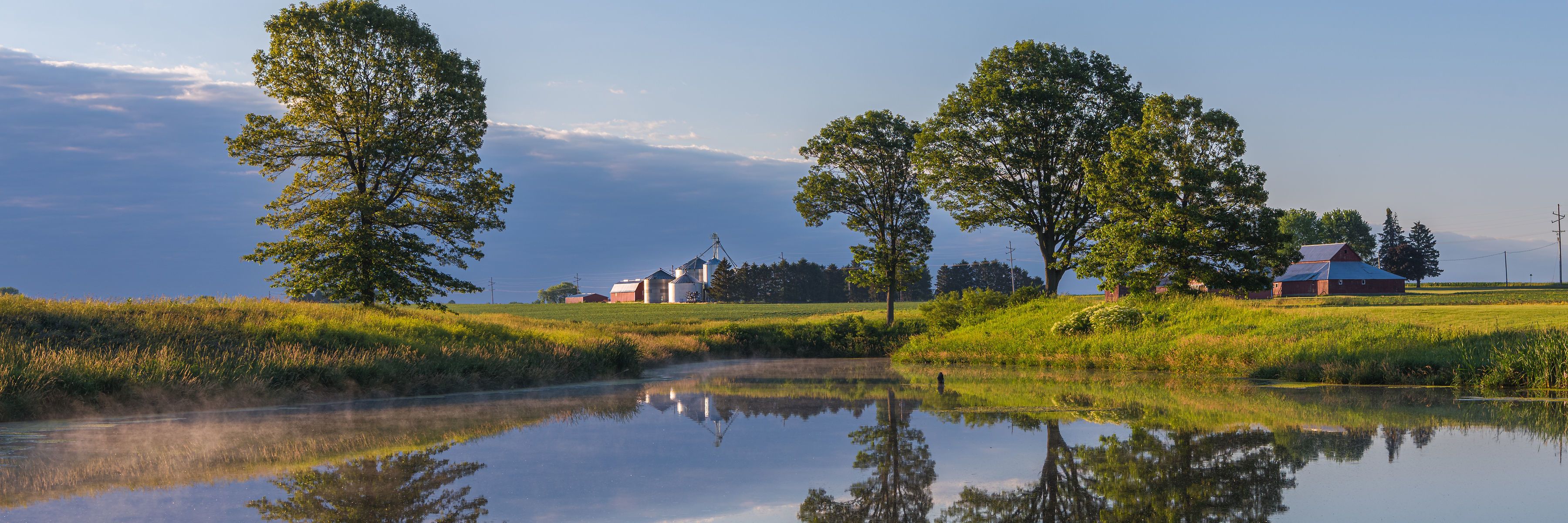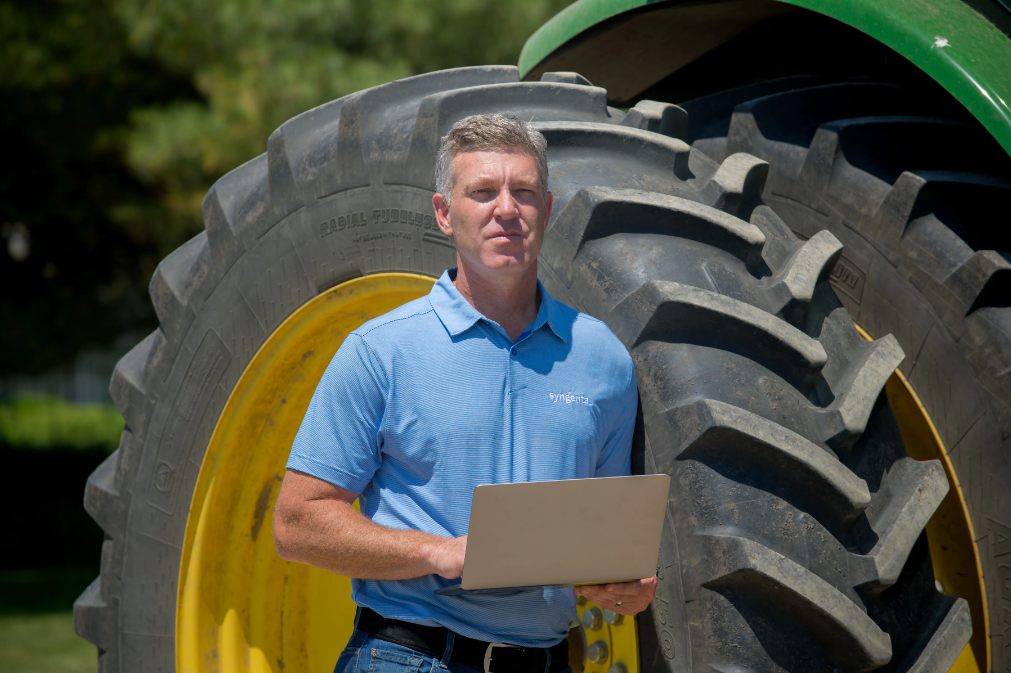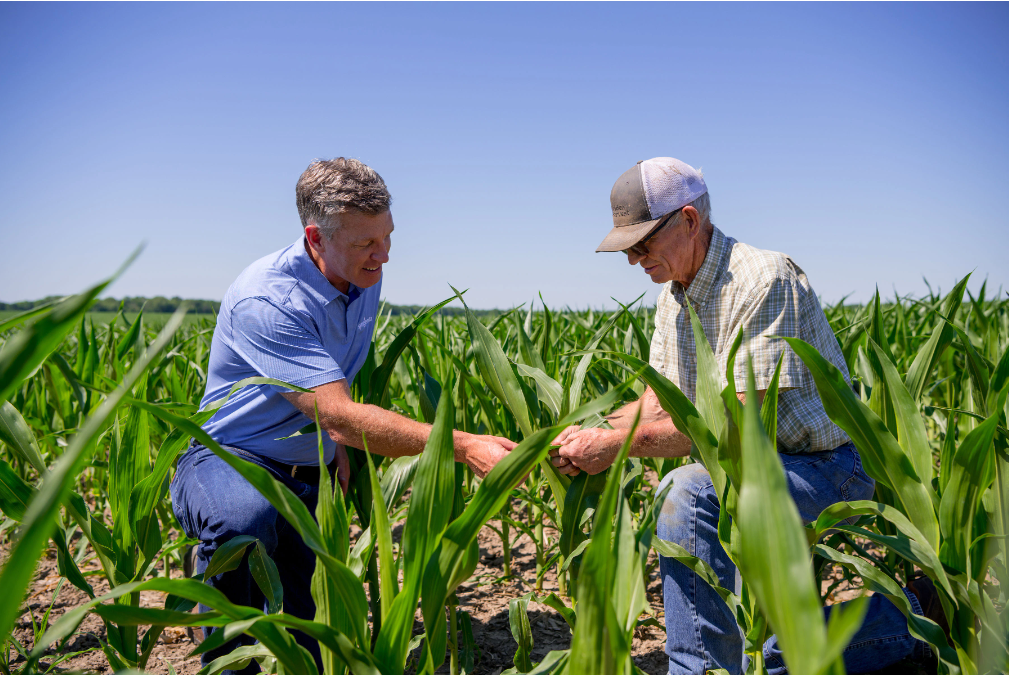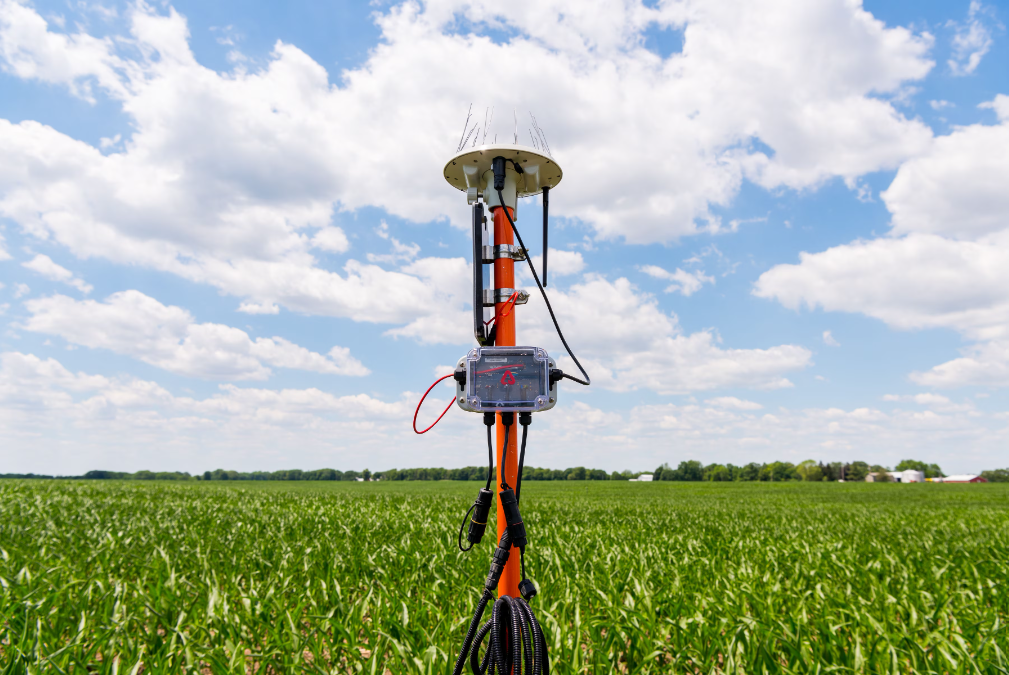Advancing Regenerative Agriculture, from one generation to the next

In Jeff Rowe’s view, regenerative agriculture must be profitable, productive, and “nature positive” to deliver benefits — and potentially reduce the effects of climate change — on a global scale.
And the best way for that to happen is through the efforts of individual farmers, often implementing best practices in sustainability over years and even generations.
A fifth-generation farmer, Rowe is putting that philosophy to work on his corn and soybean farm in northern Illinois. He is experimenting with low-till and no-till land care and with sensors and other digital technologies that help optimize the application of nitrogen, nutrients and other inputs.
Rowe knows that for a farm to be successful across several generations, embracing new innovations and trends is critical. He believes regenerative agriculture — where soil health management, plant diversity and other conservation-minded farming practices can lead to environmental benefits — likely represents the next big transition for his family farm, and for farms across the world. Some agriculture and environmental experts believe that such efforts could potentially restore and enhance the biodiversity, soil health, productivity and ecosystems of farmed lands.
Besides working the family farm with Dean, his 78-year-old father, Jeff Rowe is in a unique position to promote the benefits of regenerative agriculture widely. He is also president of Syngenta Seeds, which means he is deeply involved in the latest research and development in agriculture products and practices, providing an international platform for promoting the best practices in modern, nature-positive farming.
Tradition of stewardship
Some of the sustainability practices are relatively new on the Rowe family farm. But the nature-positive philosophy is not. Rowe is carrying on a tradition of farmland stewardship that goes back nearly 200 years in his family.
“If you think about multigenerational farmers, sustainability is really what it’s about,” says Rowe, standing at the edge of a fast-growing field of corn. “It’s about taking something and improving it throughout your career and your lifetime, so that what you hand to the next generation is in a better state.”
Rowe’s father and his mother, Carol, have been tending crops in the area for more than 50 years. And now, Rowe’s wife, Amy, and their four children are helping carry on the tradition. His relationship to the land gives Rowe a perspective that he values in his work as an agriculture executive.
“I consider myself very lucky to be in an industry that I am so connected to personally,” he says. “I draw intellectual curiosity, motivation and energy from all of the great scientists and professionals that we have at Syngenta, and then I come to the farm here and I see all of that work in action.”
Productivity gains
Rowe is fortunate for another reason: He can draw on the experience of his parents and grandparents, for everything from understanding the characteristics of different sections of a field to how to spot evidence of pests on a corn leaf. That kind of knowledge transfer is invaluable as the U.S. agriculture industry grapples with a widening skills gap amid an aging workforce. (The average age of a U.S. farmer was 57.5 years in 2017, compared to 54.3 years in 1997, according to the U.S. Department of Agriculture’s Census of Agriculture.)
On the Rowe farm, the evidence of generational progress is in every row of corn. When Dean Rowe started farming in the area in the 1960s, the corn rows were 40 inches apart, a vestige of the past when farm animals pulled the equipment. Now, 30 inches separate each row, the result of modern machinery and agronomics.
That change, along with an increase in the number of corn seeds planted on each acre and other productivity improvements, has resulted in a greater than 80% increase in yield — from 120 bushels per acre in the early days of the Rowe farm to 220 bushels per acre today.
Significantly, sustainability advances have accompanied those productivity gains. The narrowing of rows results in more shade for the soil, which in turn leads to improved moisture retention and weed control. And, with both tilled and low-till soil, fallen residue from the harvested corn functions much like a cover crop during the off-season and as mulch for the next growing season.
Farm equipment has advanced in many ways over the years, as well. In the 1960s, Dean Rowe could purchase a basic tractor-pulled planter for a few hundred dollars. Now, the retail price for a state-of-the-art planter with variable rate seeding, pneumatic controls, and other high-tech features can be hundreds of thousands of dollars.
Here too, technological progress has come with sustainability benefits. The GPS-equipped farm machinery can be programmed for precision planting and crop care, minimizing over-application of fertilizers and other products. That contributes to soil health and water quality.
And, while the Rowe farm does not irrigate its 3,000 acres that span a 30-mile radius, the Rowes have graded the land in places for a more even distribution of rainwater. Every drop of water counts, as the parched early summer of 2021 has demonstrated.
Soil health
Jeff Rowe is looking to advance the farm’s sustainability efforts in new ways. The Rowe farm is participating in a Syngenta Group research project called “Bin Buster” that is experimenting with innovative technologies — including field-level weather stations and spore sensors that use artificial intelligence to evaluate the risk of disease.
These digital technologies help provide a real-time view into many aspects of field health throughout the growing season. “We’re tracking weather data on an hourly basis in an ultra-local way,” says Rowe.
One area of focus for the Bin Buster project is soil-health management and establishing baseline metrics to continuously measure and monitor soil health. Other objectives include fine tuning the application of nitrogen and fungicide, using as little as possible and only in the precise locations needed. Another goal is determining how soil genome sequencing can be used in analysis of microorganisms.
Bin Buster aims to produce not just more data, but more actionable data. “The amount of data that is available to farmers is light years ahead of what it was twenty years ago,” says Rowe. “What really gets value is when you use analytics on that data to come up with valuable insights.”
The field-level data will be entered into Syngenta’s Cropwise farm management software and shared with other data platforms to provide baseline sustainability metrics on greenhouse gas emissions, energy use efficiency, soil carbon and more.
Deep Science
This kind of data-driven farming can help establish a business case for regenerative agriculture that goes beyond the long-term environmental benefits, as important as those are.
Rowe describes it as a “systems-based approach” that can help growers reduce the use of chemicals and fertilizers, where appropriate, while increasing farm output and profitability.
More than anything else, it’s the deep science of agronomic management that may be what most distinguishes Jeff Rowe’s generation of farmers from that of his parents and grandparents.
“My great, great grandfathers would have been doing things dramatically differently than we're doing on this farm today,” he says. “But I guarantee you, the mindset was basically the same — which is how can I take the best technology, the best practices that I have available to me on my farm, and make sure that what I hand to the next generation is stronger?”
Land stewardship is both a responsibility and an opportunity, Rowe says. That explains why regenerative agriculture holds such great promise, now and for future generations.

Jeff Rowe, president of Syngenta Seeds, is experimenting with low-till and no-till land care, along with new digital technologies, to manage and improve soil health. Credit: Anthony Collins for Syngenta
Jeff Rowe, president of Syngenta Seeds, is experimenting with low-till and no-till land care, along with new digital technologies, to manage and improve soil health. Credit: Anthony Collins for Syngenta

Jeff Rowe and his father, Dean Rowe, inspect the corn crop for signs of pests — a knowledge-sharing collaboration that is vital to their multi-generation family farm. Credit: Anthony Collins for Syngenta
Jeff Rowe and his father, Dean Rowe, inspect the corn crop for signs of pests — a knowledge-sharing collaboration that is vital to their multi-generation family farm. Credit: Anthony Collins for Syngenta

The Rowe farm is one of the sites for Syngenta's experimental Bin Buster program, which uses sensors and other digital technologies to collect up-to-the-minute field data. Credit: Anthony Collins for Syngenta
The Rowe farm is one of the sites for Syngenta's experimental Bin Buster program, which uses sensors and other digital technologies to collect up-to-the-minute field data. Credit: Anthony Collins for Syngenta

